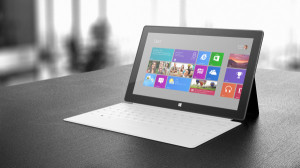 Microsoft will make it easier for Wall Street and industry analysts to track revenue generated by the company’s struggling Surface line of tablets, the company promised Thursday.
Microsoft will make it easier for Wall Street and industry analysts to track revenue generated by the company’s struggling Surface line of tablets, the company promised Thursday.
In a conference call with analysts last week, Microsoft spelled out the new format it will use next month to report its quarterly financials.
The new format, required because of the major corporate restructuring the company announced in July, will provide “more transparency, greater accountability and better execution,” pledged Frank Brod, Microsoft’s chief accounting officer.
As part of that transparency, Microsoft said it will provide analysts with “key performance indicators,” or KPIs, for a wide range of metrics. The KPIs are meant to supplement the numbers issued in the earnings press release and the “management discussion and analysis,” abbreviated as MDNA, included in the filing with the US Securities and Exchange Commissions (SEC).
Among the KPIs that Microsoft’s promised to provide will be the quarterly revenue from sales of the Surface and the accessories that accompany the tablets, such as the keyboard covers and the upcoming docking station.
“Starting in Q1 we will report quarterly the revenue derived from our Surface products and related accessories,” said Chris Suh, manager of Microsoft’s investor relations, in the call last week.
Microsoft’s first quarter for its 2014 fiscal year ends September 30, and is equivalent to the calendar’s third quarter. The company will release the quarter’s numbers on October 24.
Microsoft first disclosed Surface revenue in July when it reported second calendar quarter earnings, its fourth quarter for fiscal 2013. At the time, it said the Surface line-up had generated $853 million in revenue during the stretch from the October 2012 launch of the Surface RT to June 30, 2013. The amount was notable in part because it was less than the $900 million write-off Microsoft took to account for aggressive Surface RT discounts as well as excess inventory.
However, Microsoft has never revealed the number of Surface tablets it has sold, and is unlikely to do so going forward, according to Suh’s comment that the KPI will deliver “revenue derived from our Surface products.”
Microsoft’s new Hardware group’s gross margin plunged by 62 percent in 2013 compared to the year before, in part because of a $900 million charge for discounted and unsold Surface RT tablets. (Image: Microsoft.)
By comparison, Apple regularly reports not only iPad revenue but also the units sold during a quarter. The two numbers let analysts track such things as the ASP, or “average selling price” of the iPad. Apple’s tablet ASP dropped to $436 in the second quarter, a year-over-year decline of 19 percent, which experts interpreted as an increase in sales of the lower-priced iPad Mini tablets as a percentage of all iPad sales.
Analysts tried to estimate the number of Surface tablets shipped or sold based on the $852 million in revenue, but had limited success. That job will not be any easier next month when Microsoft issues the next earnings statement and Surface KPI. During part of the quarter – the period from June 1 to September 30 – Microsoft slashed the price of the Surface RT up to 30 percent and cut the price of the Surface Pro as much as 11 percent.
The new Surface 2 and Surface Pro 2 tablets, which will start at $449 and $899, respectively, will not be included in the third calendar quarter’s results, but will appear in the fourth quarter’s, which Microsoft will report in the second half of January 2014.
Microsoft also confirmed that a small amount of Surface-related revenue will be recorded under the “Licensing” section of the Devices and Consumer division, rather than under “Hardware.” That revenue, said Microsoft, was for a portion of the Windows licence assigned to the Surface tablet.
Most of the value of the Windows license is included with the Surface tablet revenue under Hardware, but a bit – Brod said the “cost basis” of the licence – would be booked under Licensing.
Keith Weiss, an analyst with Morgan Stanley, first posed the question that prompted Brod’s answer, but Weiss was trying to get Microsoft to explain how it will account for Windows Phone license revenue on the smartphones it sells after the company wraps up the Nokia acquisition early next year.
Brod declined to outline how Windows Phone licences would be recorded after the absorption of Nokia, but his answer about split revenue for the Surface hinted at the same for smartphones in 2014.





